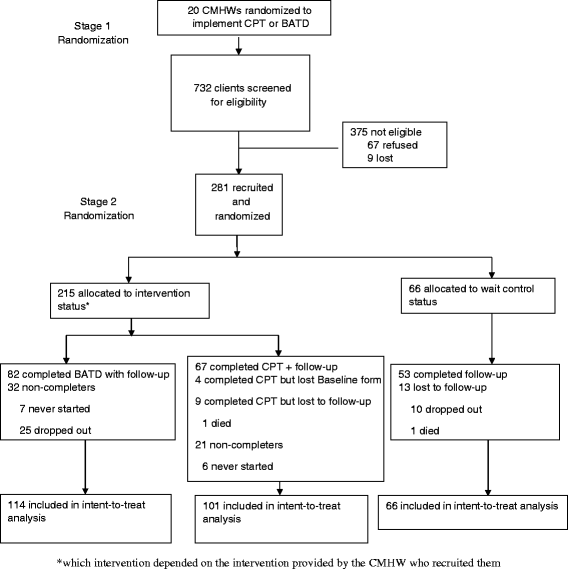A randomized controlled trial of mental health interventions for survivors of systematic violence in Kurdistan, Northern Iraq
- PMID: 25551436
- PMCID: PMC4301059
- DOI: 10.1186/s12888-014-0360-2
A randomized controlled trial of mental health interventions for survivors of systematic violence in Kurdistan, Northern Iraq
Abstract
Background: Experiencing systematic violence and trauma increases the risk of poor mental health outcomes; few interventions for these types of exposures have been evaluated in low resource contexts. The objective of this randomized controlled trial was to assess the effectiveness of two psychotherapeutic interventions, Behavioral Activation Treatment for Depression (BATD) and Cognitive Processing Therapy (CPT), in reducing depression symptoms using a locally adapted and validated version of the Hopkins Symptom Checklist and dysfunction measured with a locally developed scale. Secondary outcomes included posttraumatic stress, anxiety, and traumatic grief symptoms.
Methods: Twenty community mental health workers, working in rural health clinics, were randomly assigned to training in one of the two interventions. The community mental health workers conducted baseline assessments, enrolled survivors of systematic violence based on severity of depression symptoms, and randomly assigned them to treatment or waitlist-control. Blinded community mental health workers conducted post-intervention assessments on average five months later.
Results: Adult survivors of systematic violence were screened (N = 732) with 281 enrolled in the trial; 215 randomized to an intervention (114 to BATD; 101 to CPT) and 66 to waitlist-control (33 to BATD; 33 to CPT). Nearly 70% (n = 149) of the intervention participants completed treatment and post-intervention assessments; 53 (80%) waitlist-controls completed post-intervention assessments. Estimated effect sizes for depression and dysfunction were 0.60 and 0.55 respectively, comparing BATD participants to all controls and 0.84 and 0.79 respectively, compared to BATD controls only. Estimated effect sizes for depression and dysfunction were 0.70 and 0.90 respectively comparing CPT participants to all controls and 0.44 and 0.63 respectively compared to CPT controls only. Using a permutation-based hypothesis test that is robust to the model assumptions implicit in regression models, BATD had significant effects on depression (p = .003) and dysfunction (p = .007), while CPT had a significant effect on dysfunction only (p = .004).
Conclusions: Both interventions showed moderate to strong effects on most outcomes. This study demonstrates effectiveness of these interventions in low resource environments by mental health workers with limited prior experience.
Trial registration: ClinicalTrials.Gov NCT00925262 . Registered June 3, 2009.
Similar articles
-
Community-based mental health treatments for survivors of torture and militant attacks in Southern Iraq: a randomized control trial.BMC Psychiatry. 2015 Oct 14;15:249. doi: 10.1186/s12888-015-0622-7. BMC Psychiatry. 2015. PMID: 26467303 Free PMC article. Clinical Trial.
-
A randomized controlled trial of a transdiagnostic cognitive-behavioral intervention for Afro-descendants' survivors of systemic violence in Colombia.PLoS One. 2018 Dec 10;13(12):e0208483. doi: 10.1371/journal.pone.0208483. eCollection 2018. PLoS One. 2018. PMID: 30532155 Free PMC article. Clinical Trial.
-
A transdiagnostic community-based mental health treatment for comorbid disorders: development and outcomes of a randomized controlled trial among Burmese refugees in Thailand.PLoS Med. 2014 Nov 11;11(11):e1001757. doi: 10.1371/journal.pmed.1001757. eCollection 2014 Nov. PLoS Med. 2014. PMID: 25386945 Free PMC article. Clinical Trial.
-
Mental health interventions and priorities for research for adult survivors of torture and systematic violence: a review of the literature.Torture. 2016;26(1):17-44. Torture. 2016. PMID: 27857003 Review.
-
Traumatized refugees: morbidity, treatment and predictors of outcome.Dan Med J. 2014 Aug;61(8):B4871. Dan Med J. 2014. PMID: 25162447 Review.
Cited by
-
Problem-solving therapy for pregnant women experiencing depressive symptoms and intimate partner violence: A randomised, controlled feasibility trial in rural Ethiopia.PLOS Glob Public Health. 2023 Oct 27;3(10):e0002054. doi: 10.1371/journal.pgph.0002054. eCollection 2023. PLOS Glob Public Health. 2023. PMID: 37889918 Free PMC article.
-
A digital mental health intervention to reduce depressive symptoms among overseas Filipino workers: protocol for a pilot hybrid type 1 effectiveness-implementation randomized controlled trial.Implement Sci Commun. 2020 Oct 31;1:96. doi: 10.1186/s43058-020-00072-y. eCollection 2020. Implement Sci Commun. 2020. PMID: 33145495 Free PMC article.
-
Community Health Workers as Mental Health Paraprofessionals: Protocol for a Mixed-Methods Pilot Feasibility Study.JMIR Res Protoc. 2024 Sep 12;13:e57343. doi: 10.2196/57343. JMIR Res Protoc. 2024. PMID: 39264699 Free PMC article.
-
Development and Preliminary Feasibility Study of a Brief Behavioral Activation Mobile Application (Behavioral Apptivation) to Be Used in Conjunction With Ongoing Therapy.Cogn Behav Pract. 2018 Feb;25(1):44-56. doi: 10.1016/j.cbpra.2017.05.004. Epub 2017 Jun 6. Cogn Behav Pract. 2018. PMID: 29725198 Free PMC article.
-
Male and LGBT survivors of sexual violence in conflict situations: a realist review of health interventions in low-and middle-income countries.Confl Health. 2020 Feb 26;14:11. doi: 10.1186/s13031-020-0254-5. eCollection 2020. Confl Health. 2020. PMID: 32127913 Free PMC article. Review.
References
-
- Steel Z, Chey T, Silove D, Marnane C, Bryant RA, van Ommeren M. Association of torture and other potentially traumatic events with mental health outcomes among populations exposed to mass conflict and displacement: a systematic review and meta-analysis. JAMA. 2009;302(5):537–549. doi: 10.1001/jama.2009.1132. - DOI - PubMed
-
- Lien L, Thapa SB, Jon AR, Kumar B, Hauff E. Premigration traumatic events and psychological distress among five immigrant groups: Results from a cross-sectional study in Oslo, Norway. Int J Ment Health. 2010;39(3):3–19. doi: 10.2753/IMH0020-7411390301. - DOI
-
- Willard CL, Rabin M, Lawless M. The Prevalence of Torture and Associated Symptoms in United States Iraqi Refugees. J Immig Minority Health 2013 Apr 6. [Epub]. - PubMed
-
- Alexander A, Blake S, Bernstein MA, The staying power of pain A comparison of torture survivors from Bosnia and Colombia and their rates of anxiety, depression and PTSD. Torture Q J Rehabil Torture Vict Prev Torture. 2007;17(1):1–10. - PubMed
-
- McColl H, Higson-Smith C, Gjerding S, Omar MH, Rahman BA, Hamed M, El Dawla AS, Fredericks M, Paulsen N, Shabalala G, Low-Shang C, Valadez Perez F, Colin LS, Hernandez AD, Lavaire E, Zuniga APA, Calidonio L, Martinez CL, Abu Jamai Y, Awad Z. Rehabilitation of torture survivors in five countries: common themes and challenges. Int J Ment Health Syst. 2010;4:16. doi: 10.1186/1752-4458-4-16. - DOI - PMC - PubMed
Publication types
MeSH terms
Associated data
LinkOut - more resources
Full Text Sources
Other Literature Sources
Medical


